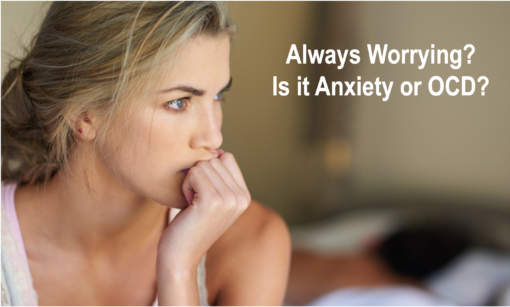Do you have symptoms of OCD or Anxiety, but aren’t sure what the difference is?
Would you like clarity on what your symptoms mean?
Sometimes you may feel or sense something isn’t quite right, however aren’t sure what your symptoms mean. It’s ok to feel like this – often we don’t understand our actions or decisions, and need a little advice to bring clarity.
Constant Worrying!
If you find yourself worrying all the time, you may have created a particular way of calming yourself down (e.g. you tap 3 times). Or, that constant worry doesn’t go away no matter what you do. Nothing calms you down. It more frequent than you may think to wake up everyday with looming anxiety about anything and everything (e.g. feeling unsettled you haven’t cleaned the house or got the washing done, whether you’ll be late for work, or that you have uni work still to do).

It can feel like you’re stuck in an anxious cycle. Don’t worry, I’m here to bring you that clarity you’ve been searching for.
OCD vs. Anxiety – How You Can Tell the Difference
There is a clear difference between OCD (Obsessive Compulsive Disorder) and Anxiety (GAD-Generalised Anxiety Disorder), but often the two can be confused. There is also a clear difference between being a ‘neat’ person, or perfectionism and OCD tendencies.
| Anxiety (GAD-Generalised Anxiety Disorder) | OCD (Obsessive Compulsive Disorder) |
| – Rumination (thinking about things over and over) – Usually about real life/every-day concerns (e.g. school, work, finances, relationships). In other words, your worries are global and about a range of things – You do not have compulsions/rituals attached to the worries – Worries are congruent – Nothing calms you down | – Obsessional thoughts or images: distressing, intrusive. Unrealistic expectations of the outcomes of your fears – Worries are often less realistic than those in GAD, e.g. the consequences of what will happen – You experience compulsions, e.g. ritualistic behaviours which neutralize the anxiety (e.g. washing hands, checking a light-switch, worried you’ll get hurt if you step on a crack and need to jump over the crack with only your left foot) – Worries are incongruent (the intrusive thoughts are not consistent with your values/wants/beliefs) |
Did You Know?
OCD affects 1.1%-1.8% of people*, and females are affected at a slightly higher rate than males in adulthood. Males, however are more commonly affected in childhood.
The treatment for OCD and GAD are very different and correct diagnosis with steps on how to move forward in your life is pivotal.
Small Actions For At Home
Trying to understand what different mental health symptoms mean for you on your own is difficult. There can be so much confusion!
Ensuring you receive the right information on your symptoms, what they mean, and how to correct them or move forward is important and shouldn’t be overlooked.
Try these tips at home:
- Notice whether something simply annoys you, e.g. whether the radio volume is on an odd number but you have no strong or distressing urge to change it. Can you leave it without it upsetting you? Or does it make you distressed if you don’t fix it, making you preoccupied with it (this could be a defining feature of OCD, depending on how you experience it).
- Take notice whether you have any repetitive behaviours that help you feel better (e.g. tapping, counting, checking, making a cross across your chest etc) – if you do, this is more aligned with OCD.
- Try writing down all the thoughts that stress you out (e.g. whether the house will burn down, that there might be germs on the table), then write why each one of these stresses you out (e.g. someone may die, get sick, or be hurt). Then lastly write whether there are any compulsions or repetitive behaviours attached to make this fear go away (or does the fear stay with you all day?).
- Lastly, take the list with you and talk to a psychologist. They will give you the clarity, tools, and plans you need to combat your symptoms for a more relaxed, calm future.
Written by Kaja Porter – Clinical Psychologist – www.creatingchange.net.au
*International statistic average (DSM-5)

